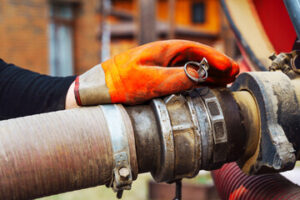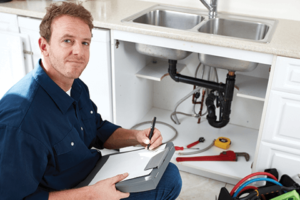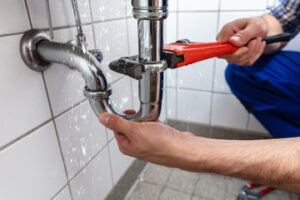Plumbing involves the installation, maintenance, and repair of water supply and waste disposal systems in buildings and infrastructure. It is essential for ensuring clean water and preventing the spread of disease and infection.

Plumbing can seem complicated, but understanding the basics can help avoid expensive repairs. Knowing what goes into your drains and how they work will save you money in the long run. Visit Website to learn more.
Whether it’s for drinking, bathing, washing clothes or dishes, or for fire fighting and water supply for city waterworks, the plumbing system brings fresh, clean water into your house. This is done through an underground network of pipes that deliver it directly from a water supplier. It also takes wastewater away via drains and sewer systems.
Water supply is a public service that provides potable (drinkable) water to homes, commercial establishments, industries, and other uses. It is one of the most fundamental municipal services necessary for human existence. It must meet both quality and quantity requirements.
An important part of a water supply is the water treatment plant where groundwater and surface water are treated to meet quality and quantity requirements before it is conveyed to the distribution system. The distribution system consists of pipes, valves, and fittings that distribute the treated water to households and businesses. The distribution system is often managed by a government agency, which is responsible for the collection, transmission, treatment, storage, and distribution of municipal water.
The plumbing profession has always been concerned with the movement of fluids, most notably water. Throughout history, people have developed ever-more elaborate systems for managing and transporting water, from the Persians’ qanat system in the 1st millennium BC to the ancient Romans’ expansive network of aqueducts.
Today’s plumbing is an industry that has grown to include many different disciplines. Plumbers deal with the installation, maintenance and repair of all types of plumbing fixtures, appliances, and systems. They use a wide range of tools and materials, including copper, steel, PVC, PEX, and ABS. Most states have regulations in place to license plumbers and enforce standards of practice.
A water pipe is a plastic or metal tube that carries pressurized freshwater. It may be buried in the ground or above ground, running either on its own or affixed to structures such as buildings. Water supply pipes typically run under high pressure, and are often heavily insulated to prevent condensation, which can lead to freezing and bursts. They can also be covered with a variety of coatings and materials to provide protection against corrosion, contamination, and the growth of organisms.
Drainage
The drainage system consists of pipes that carry away wastewater and rainwater to a point where it can be disposed of. This includes septic tanks, sewer lines and stormwater drains. The drainage system is essential for keeping water from backing up into a home. It is also responsible for the safe disposal of human and animal waste.
Plumbing is often confused with drainage, but the two systems have very different jobs. Plumbing is all about conveying clean water to fixtures, while drainage focuses on transporting sewage and waste matter.
While the two systems are very different, they do intersect at some points. For example, the drainage system is responsible for ridding a home of waste matter from toilets, sinks and showers. This is a crucial job, but it requires specific knowledge and equipment.
Plumbers must be well versed in drainage technology to ensure that the system is working properly. This involves understanding how to use CCTV drain cameras to inspect the condition of the drain and locate any problems or blockages. It also involves knowing how to clear drains using a variety of tools and techniques.
For example, if a drain becomes blocked with hair, soap residue or food matter, a plumber can use a drain auger to break up the obstruction and remove it. They can also install grates and covers on drains to prevent foreign objects from entering the drain.
Moreover, plumbing professionals can install gully drains to reduce erosion, flood risk and water pollution. These are typically installed at the base of slopes where the gradient changes. They also help to improve groundwater recharge and provide a natural buffer against surface water runoff.
While gully drains offer several benefits, they can have drawbacks such as low hydraulic capacity and the difficulty of sanitizing them. To address these issues, they can be fitted with a high-performance liner such as BTL AquaArmor. This liner offers superior protection from UV rays, tear resistance and punctures, which minimizes the maintenance required to keep the drains functional. It also ensures that the drains remain clog-free for long periods of time.
Waste Disposal
Waste disposal is the process of removing, discarding or recycling unwanted materials that result from agricultural, domestic and industrial products. The correct methods of waste disposal can reduce pollution and hazards for the environment. This includes avoiding hazardous chemicals entering the groundwater supply or air, which can cause illnesses in people. It also involves minimizing water pollution by reducing the amount of untreated or partially treated waste that enters rivers, lakes, or other water bodies.
Some of the most common methods for waste disposal include landfills, incineration, and sanitary landfills. Landfills are pits or areas covered with a layer of impermeable synthetic bottom liners, where solid waste is stored and compacted. This method is especially important for municipal waste and hazardous material.
Sanitary landfills are often constructed to avoid contamination of surrounding water, soil, and air. They also prevent harmful gases and smoke from escaping into the atmosphere. In addition, sanitary landfills are designed to be fly proof and free from pests.
Incineration is a method of waste disposal in which organic materials are burned to convert them into gaseous and solid wastes. This technique is commonly used to dispose of municipal and industrial wastes. However, it can be expensive and dangerous to the environment.
There are many ways to reduce waste, including by separating biodegradable from non-biodegradable items and recycling. The Environmental Health and Safety department at NYU manages the disposal of chemical and biological waste from campus buildings in accordance with federal, state and local laws.
The best way to protect the environment is not to generate waste in the first place. This can be accomplished by reducing the use of non-biodegradable products, such as plastics and metals. Other methods for reducing waste include using reusable containers, composting, and landfill avoidance.
Garbage accumulation has never been a big concern in the past, but due to globalization and industrialization, there is a need for a more efficient waste disposal method. In this process, the waste that cannot be reused is separated out and spread as a thin layer in the low-lying areas of cities. After each layer, a layer of soil is added. Once the process is complete, the area will be declared unfit for construction activities and can only be used as parks or playgrounds.
Plumbing Systems
Plumbing systems work together to supply drinking water, remove waste and direct stormwater away from buildings. They are vital in every building, from residential homes to large office complexes. Professional plumbers design, install, maintain and repair plumbing systems to ensure they are working properly and safely. This involves creating piping channels that are safe and secure for use, ensuring water is at the right temperature, and installing drains and vents to keep wastewater and air separate.
The plumbing industry is regulated at the local, state and federal level. Most governments require plumbers to be licensed to practice in their field, and they must follow strict safety standards to avoid injuries or property damage. In addition to licensing requirements, plumbers must keep up-to-date with all the latest technologies and procedures in their field. The plumbing industry is constantly evolving, and new innovations and advancements are being made all the time.
A home’s plumbing system has two distinct systems: water supply and drainage-waste-vent (DWV). The water supply pipes carry fresh, clean water from the municipal water supply to faucets and appliances throughout the house. This system includes the meter that measures how much water is consumed, and the hot-water heater that supplies the household with hot water.
The DWV system is designed to remove wastewater and keep it from clogging the toilets, showers and sinks. It comprises a network of downward-angled pipes that rely on gravity to move waste water into the sewer line. It also includes the traps that prevent bad odors from entering the house, and the vents that keep air pressure at a steady level throughout the house.
During the rough-in phase of construction, a plumbing contractor establishes the connections for the DWV system. This includes locating the locations of the supply and waste lines, and determining the size of the pipe needed to transport water to and from each fixture. Once the piping is in place, the contractor can complete the installation of the fixtures and connect them to the plumbing system.
The most important element of any plumbing system is the pipes. These serve as pathways for water to reach its destinations, and they must be strong enough to withstand the pressure of water and other liquids. The pipes are usually made of PVC, PEX or copper. PEX is more flexible than PVC, so it’s easier to install in tight spaces. Copper is more expensive than PEX, but it’s harder to cut or bend, so it’s often used in larger diameter pipes.








